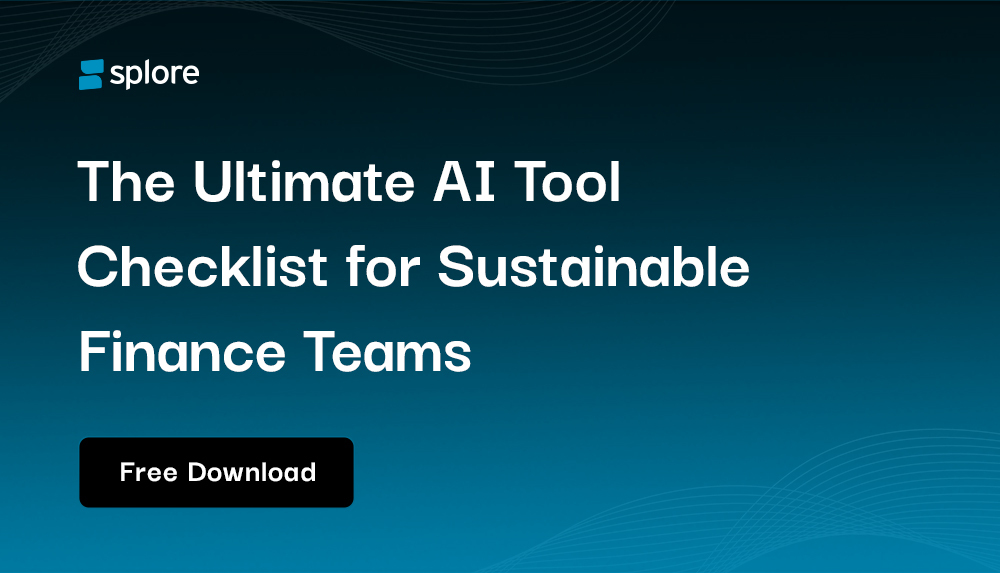| It is time to ditch outdated tools. AI streamlines ESG data, automates reporting, and keeps you ahead of regulations. The right AI solution cuts compliance errors, uncovers green investment opportunities, and boosts team efficiency. Download our free checklist to choose the best tool, avoid mistakes, and lead the future of sustainable finance. Sustainable finance is growing faster than ever before. |

Find the Perfect AI Tool for Sustainable Finance
AI is transforming sustainable finance from ESG tracking to smarter risk assessments. This checklist helps you choose the right tool to maximize returns, boost ESG performance, and stay compliant.
- ESG Data Automation
- Real-Time Risk Alerts
- Custom ESG Scoring
- And more!
Download Free
All fields are required.
As ESG mandates become the gold standard, financial teams find themselves grappling with mounting pressure from regulators, stakeholders, and clients alike. The explosion of sustainable investments, a staggering 29% growth reported by Bloomberg has brought new challenges and heightened urgency.
- Fragmented ESG data scattered across sources
- Time-intensive reporting cycles with inconsistent formats
- Limited visibility into real-time sustainability risks
- Struggles to align with shifting global regulatory standards
Meeting these hurdles head-on demands smarter, faster, and more precise action. That’s where AI in sustainable finance becomes a game-changer. The right tools reduce errors, speed up impact reporting, and unlock greener opportunities.
Our free checklist, 'How to Choose the Right AI Tool for Sustainable Finance,' guides your team through the evaluation process with clarity and confidence. This blog highlights key factors to consider ensuring your choices align with compliance needs and deliver real impact.
How AI Simplifies Sustainable Investing?
Finance professionals need to do more than check boxes, they must lead with vision, strategy, and adaptability. Artificial intelligence provides just that edge.
Here are key ways AI simplifies sustainable investing:
- Unified ESG & Impact Data
AI consolidates environmental, social, and governance data from multiple sources into a single dashboard, offering clarity over complexity. This unified approach ensures all stakeholders work from the same foundation.
Here’s what a strong AI tool should offer when consolidating ESG data:
- Combines structured and unstructured ESG datasets for holistic insight
- Extracts relevant disclosures from regulatory filings and sustainability reports
- Normalizes data across diverse frameworks (e.g., GRI, SASB, TCFD)
- Enables faster data extraction with built-in NLP
- Powers data-driven investing using consistent, trustworthy information
- Real-Time ESG Risk Alerts
AI tools continuously monitor environmental and governance factors across global markets. As such, these tools flag material risks before they escalate, enabling proactive action.
These are the key capabilities your AI tool should include for real-time risk monitoring:
- Tracks regulatory updates impacting ESG compliance
- Identifies controversies and climate-related risks as they arise
- Delivers market sentiment analysis around sustainable investments
- Flags greenwashing in real time
- Offers instant alerts on reputational or carbon risk exposure
- Automated Impact Reporting
Manual reporting is no longer viable in today’s high-speed market. Hence, AI tools generate reports that are stakeholder-ready, accurate, and timely.
Look for these features to ensure your AI tool can streamline ESG reporting:
- Builds SFDR, CSRD, and TCFD-compliant disclosures with prebuilt templates
- Visualizes impact metrics for board or investor presentations
- Updates reports in real time with new ESG developments
- Links performance to net-zero and SDG goals
- Supports investor relations with consistent, branded documents
- Sustainable Investment Screening
AI solutions evaluate investment portfolios for ESG alignment, screening companies against sustainable finance criteria. This ensures capital is directed toward assets that meet environmental, social, and governance benchmarks.
These bullet points highlight how AI can optimize portfolio screening for ESG goals:
- Scores portfolios based on SDG, net-zero, and ESG performance
- Flags non-compliant or high-risk holdings
- Aligns investments with firm-specific ESG thresholds
- Tracks ESG momentum and transition risk
- Assesses sector and geography-based sustainability risk profiles
What Should Sustainable Finance Teams Look for in an AI Tool?
Choosing the right tool goes beyond fancy dashboards. Thus, teams must assess whether the technology aligns with core sustainable finance goals.
Here’s a condensed summary of our full checklist:
- Security & Compliance
Ensure AI tools align with global regulatory frameworks like GDPR, SEC, and FINRA. Top-tier platforms include real-time audit trails and encrypted environments to secure sensitive ESG data.
- Automation & AI Capabilities
Smart tools should reduce manual workload by automating ESG reporting, risk evaluation, and sustainable asset tracking using machine learning and predictive analytics.
- Integrations & Compatibility
AI solutions must integrate smoothly with CRM systems, accounting platforms, and market data providers like Bloomberg and Reuters for seamless operations.
- Usability & UX
Easy-to-use tools win. Dashboards should be customizable, intuitive, and backed by solid onboarding and user support.
- Performance & Scalability
Scalable platforms accommodate increasing data volumes without performance lags. Cloud-based tools ensure flexibility and business continuity.
- Cost & ROI
Evaluate transparent pricing models, automation benefits, and efficiency improvements. Consider long-term ROI over short-term cost.
- Data Analytics & Reporting
AI tools must offer real-time analytics, predictive forecasting, and presentation-ready reporting capabilities.
- Customization & Flexibility
Solutions must support your firm's unique strategies, offering modular features, configurable alerts, and niche analytics.
- Customer Support
Quality support includes 24/7 assistance, robust documentation, and live training modules.
- Risk Management
Effective tools include fraud detection, predictive risk alerts, and strong modeling for ESG threats.
What Are the Must-Have Features in ESG-Focused Finance Tools?
Sustainable finance teams need tools built for purpose, not repurposed analytics. These are must-have features to evaluate:
- Reliable ESG Data Integration
Strong decisions start with solid data. ESG tools must pull verified, consistent, and up-to-date information from trusted sources. This ensures every insight is backed by credibility.
Look for these data integration capabilities:
- Pulls ESG metrics from trusted providers like MSCI, Sustainalytics, or Refinitiv
- Supports scraping and data extraction from annual reports and filings
- Ensures consistency across frameworks like SASB and GRI
- Eliminates manual input and reduces transcription errors
- Centralizes structured and unstructured data for decision-making
- Automated ESG Scoring & Evaluation
Manual scoring is time-consuming and prone to bias. AI-driven scoring offers consistency, speed, and adaptability across investment portfolios. It ensures your ESG evaluations align with global standards and firm-specific goals.
Check for these ESG scoring features:
- Evaluates firms based on ESG ratings and risk factors
- Maps performance to SDG and net-zero goals
- Highlights changes in ESG rankings over time
- Aligns portfolios with custom ESG parameters
- Flags ESG laggards automatically
- Real-Time Impact & Risk Dashboard
Visual dashboards bring ESG insights to life. Teams need instant visibility into sustainability metrics and risk exposure. AI dashboards help stakeholders stay aligned and responsive.
Here’s what top-tier dashboards should include:
- Offers centralized view of ESG, carbon intensity, and diversity metrics
- Tracks climate-related disclosures and regulatory deadlines
- Uses color-coded alerts to flag underperformance
- Allows stakeholder-specific dashboard customization
- Supports scenario modeling for regulatory shifts
- Automated Regulatory Reporting
Regulations are complex and always changing. ESG tools must simplify reporting to avoid delays, errors, and penalties. Automation ensures teams stay compliant with minimal effort.
Essential features for compliance automation:
- Generates ready-to-submit SFDR, CSRD, and TCFD reports
- Keeps templates updated with evolving regulations
- Links reporting to internal ESG strategy KPIs
- Reduces compliance cycle time by over 50%
- Auditable logs to trace back every report output
- Progress Tracking & Peer Benchmarking
It’s not enough to measure, teams must improve. Tracking ESG progress and benchmarking against peers fuels better strategy. These insights help turn data into competitive advantage.
Key benchmarking capabilities to look for:
- Tracks portfolio alignment over time
- Compares ESG KPIs against peer funds
- Measures decarbonization efforts relative to sector targets
- Highlights gaps in ESG disclosures
- Builds reports around outperformance narratives

Find the Perfect AI Tool for Sustainable Finance
AI is transforming sustainable finance from ESG tracking to smarter risk assessments. This checklist helps you choose the right tool to maximize returns, boost ESG performance, and stay compliant.
- ESG Data Automation
- Real-Time Risk Alerts
- Custom ESG Scoring
- And more!
Download Free
All fields are required.
What Are the Common Pitfalls to Avoid When Choosing ESG AI Tools?
The ESG tech space is growing fast, but not all tools are built to handle the depth and complexity of sustainable finance. Flashy dashboards and bold claims often mask weak functionality and compliance gaps. Many tools promise the moon but deliver little impact.
Avoid these traps:

- Unverified ESG Scores
Some tools lack transparency in how they calculate ESG ratings, making it hard to trust the outcomes. Without validation from credible third-party sources, firms risk basing decisions on inaccurate or biased data. Relying on vague or self-reported data can lead to greenwashing and regulatory penalties.
Watch out for these red flags:
- Lack of transparency in scoring methods
- No external data validation
- Over-reliance on company-reported ESG metrics
- Conflicting ESG scores from different vendors
- Inability to drill down into scoring rationale
- Non-compliance with Regulations
Failing to meet evolving ESG disclosure standards can expose firms to legal risk and reputational damage. Non-compliant tools risk fines and erode investor confidence.
Look out for these compliance gaps:
- Absence of SFDR/TCFD compliance modules
- Outdated reporting templates
- Missing audit logs or traceability
- No country-specific regulatory support
- Gaps in GDPR-compliant data handling
- Inflexibility to ESG Changes
ESG regulations and frameworks evolve constantly, and tools must adapt just as quickly. Static tools can’t keep up with regulatory and framework updates.
Signs of inflexibility include:
- No modular upgrades
- Lack of real-time ESG framework sync
- Inability to create custom risk models
- Limited capacity to adjust scoring logic
- Rigid dashboards not tailored to client needs
- Complex and Hard to Use
When a tool is difficult to navigate, it slows teams down and drains resources. As such, complex tools result in loss of productivity.
Key usability issues include:
- Steep learning curves for onboarding
- Unintuitive UI/UX design
- Poor customer support
- Overly technical dashboards
- No training or help documentation
- Expensive with Low Automation
Not all high-priced tools deliver high-value outcomes. Price must match performance - high-cost tools with low automation waste resources.
Be cautious of these warning signs:
- Hidden fees or vague pricing models
- No clear ROI or performance gains
- Manual processes persist despite automation claims
- Low accuracy in predictive models
- Missing integrations inflate operational costs
Why Leading ESG Finance Teams Choose Splore AI?
Sustainable finance teams often face slow reporting cycles, fragmented ESG data, and constant regulatory updates. Splore AI solves these challenges by turning ESG complexity into clear, actionable intelligence.

- Unified ESG Data: Aggregates and normalizes structured and unstructured data from global ESG sources for a complete view.
- Real-Time Risk Alerts: Monitors regulatory shifts, climate events, and reputational risks, delivering instant alerts to keep you proactive.
- Automated Impact Reporting: Generates stakeholder-ready ESG and regulatory reports (SFDR, TCFD, CSRD) in minutes, not weeks.
- AI-Driven Screening: Evaluates portfolios for ESG, SDG, and net-zero alignment to surface greener opportunities faster.
- Sustainable Portfolio Analysis: Tracks carbon intensity, governance quality, and social metrics to refine investment strategy.
With Splore, ESG teams accelerate decisions, reduce compliance errors, and lead confidently in a fast-changing sustainable finance landscape.
The wrong AI tool costs more than you think. Make the right move today.
Download Free
All fields are required.
Final Thoughts: The Future of ESG Finance Runs on AI
Manual workflows no longer cut it. ESG teams must evolve or risk falling behind. The right sustainable finance tools don’t just automate, they transform. With AI, teams can move from reactive to proactive, driving impact with clarity and speed.
Refining portfolio management with AI means faster decisions, fewer errors, and stronger compliance. Embracing AI in sustainable finance equips teams to address challenges, unlock insights, and lead change.
Book a demo with Splore and see how your team can achieve more with less.
Download the Checklist Now: How to Choose the Right AI Tool for Sustainable Finance

Download Free
All fields are required.





